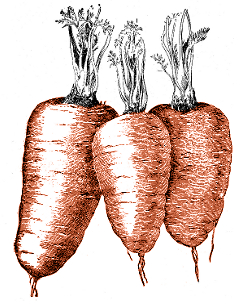Archive for the ‘Planning’ category
Posted in The New Garden, Planning, Practicalities on Sunday, May 9th 2021 (10.48 AM).
In the last post I mentioned that the new garden is a barren empty space, which was and is true. The previous owners had bought a patch of soggy, waterlogged and undraining grass, and had stripped it and all the topsoil off intending to Do Something With It, but never really did get anything done. Arriving with maybe a little more self-awareness, we realised we were going to have to bring in landscapers, at the very least, to help us come up with an outline layout and do much of the heavier work—the earthmoving, paving-laying, bed-building and so on. So now, a start has been made, and to hopefully make it a little less waterlogged the garden currently resembles the sort of artificial inland beach you find in The Netherlands.
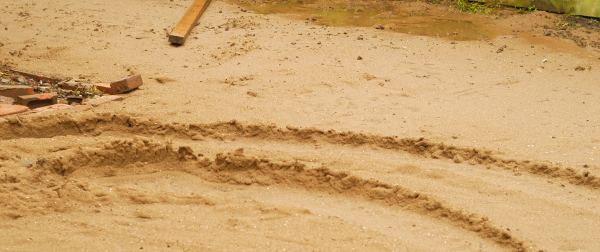
Topsoil is already on order, so hopefully before too long we will have a bare expanse of soil instead of sand. In the meantime, we’ve started buying plants to go into the beds when they are ready. Fingers crossed they won’t have to sit in their pots too long.
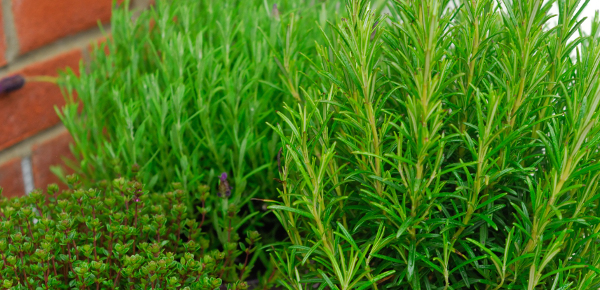
Unsurprisingly, herbs are the first thigng to be bought.
thyme, rosemary, lavender, Lavandula, Salvia rosmarinus, Rosmarinus officinalis, Thymus
Posted in Planning, Practicalities, The Old Garden In Bristol on Thursday, August 20th 2020 (7.15 PM).
When this blog first started in 2011 I drew a sketchplan of the garden and have referred back to it in posts here a few times since. It only recently occurred to me that now I have a better phone than I did then, I could get the same effect by leaning out of the bathroom window. So here is what the garden currently looks like, more or less, in yesterday’s rainstorm. Please excuse the chopped-down brambles wilting on the roof of the shed.
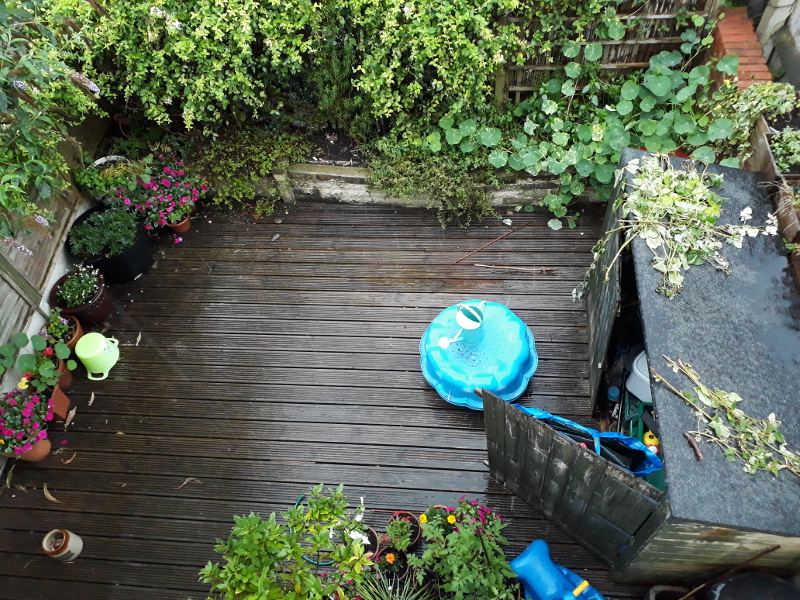
plan, overview
Posted in Children, Experimentation, Garden Diary, Planning, Practicalities, The Old Garden In Bristol on Tuesday, March 29th 2016 (9.56 PM).
Spring has come around, and the brambles are slowly being hacked back. At least once a week, if the weather has been dry enough, I have been going outside, gloves on, and cutting my way into them. There aren’t many garden jobs I will wear gloves for, but demolishing brambles is one of them.
This has to be the year I get on top of the garden and get interested in it again, because the children—now aged two and a quarter—have started to take an interest in it themselves, partly because of me going out to hack the brambles down. “Me help garden!” says The Child Who Likes Fairies each time I look as if I’m about to go out there. Her “help” consists mostly of moving mud from place to place, of course; we gave her an old spoon in the hope she wouldn’t use her hands, but of course she does use her hands.
Given that the garden has been abandoned for two and a half years, more or less, not much is salvageable. One thing I have learned about keeping a largely container-based garden is that it does indeed require a lot of maintenance, because you don’t really end up creating a self-seeding ecosystem other than one based around dandelions. The bay bush that stands in an IKEA dustbin is doing just fine; the last potato crop in the other IKEA dustbin seems to have turned perennial, the foliage looking steadily less healthy each year. There is a pot of lavender which looks lively; a pot of rosemary which looks OK; and another rosemary and a purple sage which look as if they might survive, if we apply the defibrillator. Apart from that, there are a lot of pots filled with weeds or bare compost, and a goodly number of wooden containers in varied states of decay.
So, what to do? Back to basics, that’s what. Back to what we did five years ago when we decided we wanted to do something with our garden: go down to the garden centre, buy some plants, and see what we can make with them. The very first pots we bought are still in great condition, probably because they’re not just plain terracotta, so into them the plants go. Let’s see what happens.
There are a couple of tenets we’re trying to stick to this time. Firstly, we have children now, so it’s their garden too. The garden has to be safe for them to play in, have room for them to play in, and they need to be able to get involved in it. Secondly, we have much less time than we used to, so it has to be simple to maintain. We might only have a tiny garden, but we no longer have time to care for it on a square-millimetre basis. The other tenets are the same as always: organic principles as far as possible, things to be ideally productive, in some broad sense, as well as attractive, and the deliberate avoidance of neat rows and unnaturally bare soil. So the plants that have gone into pots today are:
- Lemon thyme, Thymus x citriodorus.
- Purple sage, Salvia officinalis purpurascens. Yes, even though we have one already just hanging on, and we’ve never had much success with sage previously. I am blaming our previous failures on small pots and over-watering.
- Green fennel, Foeniculum vulgare.
- French marjoram, Origanum onites.
- Creeping thyme, Thymus praecox “coccineus”. No, you can’t eat this one.
As The Child Who Likes Fairies has already shown herself highly skilled at moving soil from one place (usually pots) to another (usually the decking), we let her and her brother help repot them all. She quickly picked up the idea of moving compost from bag to pot. The Child Who Likes Animals, on the other hand, preferred to run around the garden as fast as he could, but he definitely seemed to be enjoying it too. Even when the rain started, they didn’t want to stop. “Me like rain,” TCWLF said. Next time, we might even let them plant some seeds.
back from the dead, creeping thyme, fennel, french marjoram, green fennel, herbs, lemon thyme, marjoram, purple sage, sage, summary, thyme
Posted in Garden Diary, Planning, Retrospective, The Old Garden In Bristol on Saturday, September 7th 2013 (10.29 PM).
Regular readers of this site – all one of you – might have noticed that things have been rather quiet for a while here. There is, of course, a good reason for that. The reason is: the state of the garden, in the second half of last year, was such a disaster that I really didn’t feel like writing about it. I really didn’t feel like going into the garden. And so, nothing was put away for the winter, everything was left to fend for itself. A surprising amount of plants survived the winter, but the ones that did were mostly killed off by the heat earlier this summer. So now, effectively, we are starting again. The only produce we’ve had from the garden in 2013 is a small bowl from an interloper, something very tasty that we didn’t really ask for.
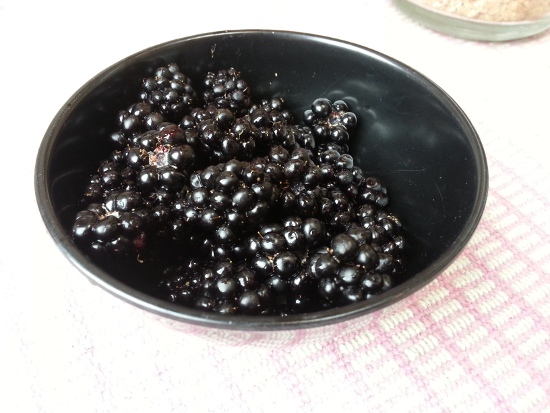
For some reason, gardening tasks always seem to end up involving brambles. I can dimly remember, aged about 5, my grandfather giving my parents a bramble shoot with the advice to keep it in a bucket lest it take over the whole garden. Naturally, by the time I had reached my teens, it had taken over, well, half the garden (the rest was lawn), and I spent what seems in memory to be most of a summer cutting it down, piece by piece, first with secateurs then with hacksaw, until my parents’ only option was to hire a wood chipper to deal with the pile of chunks. At the previous place we lived in Bristol, there was virtually no garden, and the only gardening task I ever did was regularly chop back a bramble which had managed to root itself under the decking. They really are amazing plants, in their ability to cover an area, take it over, turn everything underneath into a barren desert, and like bindweed they are endemic in this part of Bristol. So when I saw bramble runners sprouting forth over our back fence and dropping down seeking earth, I knew it had to go. After we’d eaten its fruit, of course.
The origin of the bramble is quickly explained, if we skip back to the garden plan posted a couple of years back:
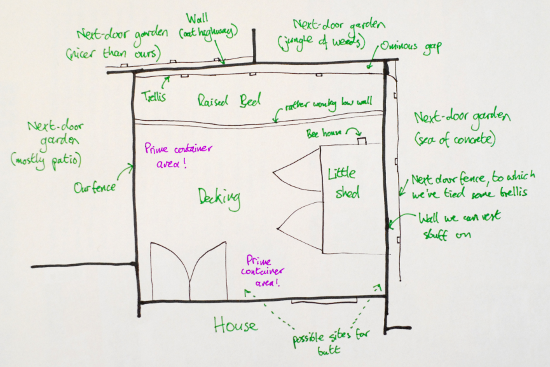
That area at top-right marked “Jungle of weeds” was all dug up about a year ago. They now have a shed, backing on to our boundary, and a high wooden fence extending off to the right. However, the cleared land on their side of said fence has been left to revert back to weediness. With their new fence, there is now double the Ominous Gap marked on the plan, and it’s this gap which has been colonised by bramble. I can reach down and chop off anything threatening to poke its way over into our space, but I have no hope at all of digging up the roots. In other words, my life is once again doomed to regularly cutting back brambles.
Apart from the bramble-hacking, what are we going to do now that we’ve admitted we’re going to restart from scratch? Try to plant things that don’t take as much nursing, for one thing, so that the garden will survive if we want a summer holiday; and things that don’t necessarily look appetising to every slug and snail in town. Lots of herbs, lots of insect-attracting flowers, and maybe the odd item of produce that we can’t easily buy here. For now, we’ve cut down the weeds that were colonising the back bed and sowed white clover for the winter, to refresh its nitrates and try to give the weeds no space to come back. Before the winter, we’ll start growing a bulb’s worth of garlic, and sow our spring flowers: of all last year’s produce, the garlic was the best harvest, and was barely touched by pests. Then, next year, hopefully things will be green again.
blackberry, bramble, clover, garlic, weeds, white clover
Posted in Experimentation, Garden Diary, Planning, The Old Garden In Bristol on Saturday, April 7th 2012 (9.44 PM).
The long Easter weekend: time to catch up on the planting schedule, and get some digging done. In the past couple of weeks, we have:
- Planted more peas.
- Planted green beans and runner beans, to germinate on the windowsill
- Planted some coriander to grow from seed
It does feel as if I should be doing an awful lot more, given the season and the warming of the weather. It doesn’t help that Symbolic Towers has, literally, nothing more than a single windowsill for plant germination, and despite last week’s warm spell the ground still isn’t warm enough for outdoor plants to be moving very quickly.
The potatoes are springing up, though, with lovely dark red foliage. Unfortunately only two of the tubers seem to have grown, so I slyly slipped another into the depths of the container at the start of this week. No sign of it coming up yet; but it means that the earthing-up has become rather uneven, the soil inside the container now having a mountainous slope to it.
The first of the seeds we saved last autumn have been planted. Of a batch of six green beans, only one came up: it has been planted outside, with poles to climb up, and is looking a little lonely. Hopefully the next batch of green beans – put under plastic to germinate this time – will have a greater success rate. At least the bamboo poles give the garden some height, something that has been missing since last year’s batch of beans was finally cut down last November. The second batch of peas has now been planted out too; the first are a tangled mass of interlocking tendrils quickly climbing up each other’s arms.
What will be coming next? Well, there are still more potatoes to plant. Moreover, with the drier weather I’ve been able to restart work on digging up the back bed. I think I mentioned that project back when this blog first started: basically, as the walled bed at the back of the garden was full of broken glass and bindweed roots, we decided to dig it all out completely and sift through all the earth; I didn’t fancy, some time in the future, to plunge my fingers into the ground without thinking and stab them on a pointy shard. It has taken a while, but the end of the digging-up project is starting to come into sight; and when it does, maybe next month, we will have an awful lot more growing space to play with. So much, in fact, I’m not entirely sure what we will do with it all. Maybe it’s time I started looking into perennial vegetables that don’t mind a slightly shady spot.
back bed, coriander, green bean, pea, potato, runner bean, sowing, sowing plan, spring
Posted in Experimentation, Garden Diary, Photobloggery, Planning, The Old Garden In Bristol on Sunday, January 15th 2012 (11.21 AM).
Given the crisp winter weather yesterday, we went out for a walk: down to Spike Island, along the New Cut, then back round in a circle through the back streets of Southville. I noticed, all of the rosemary bushes in the front gardens of Southville are in flower at the moment. Even in January.
The rosemary bush in our garden on the other side of the city is not in flower. I say “bush”: possibly “sprig” is a slightly better word. There are signs, though, that it might be starting to bud, pale green growing tips at the base of each leaf. Something is developing, at least; I don’t know much about rosemary yet.
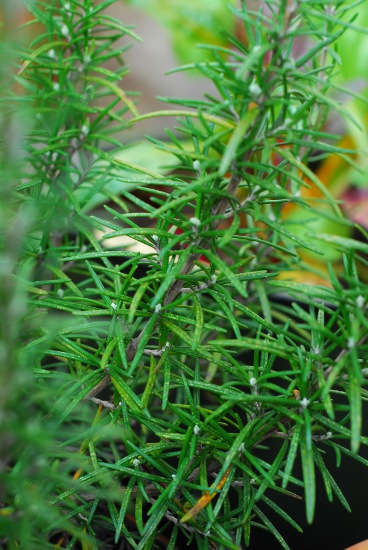
In other news, we’ve been trying to do a bit more planning on what to grow this year. We had a good harvest last year from the peas we planted, but before the season was over the plants were suffering rather badly from mildew, possibly because we planted slightly too many in each box – after all, when you only have so much space it is tempting.
I have no idea what pea variety we grew last year. Towards the end of the planting season, we popped down to the garden centre, bought whatever type of pea seedlings they had available, and that was that. “Pea” was all it said on the label. For this season, therefore, we have deliberately gone out and bought seed of a disease-resistant variety: P. sativum “Boogie”. Whether they are as tasty or fruitful as last year’s anonymous ones, we will have to wait and see, but the packet of seed peas is ready and waiting in the seed tin.
boogie, bristol, disease, flowering, mildew, pea, rosemary, southville, unseasonal, winter
Posted in Planning, Practicalities, The Old Garden In Bristol on Sunday, December 4th 2011 (10.12 PM).
In the news the other day: the ongoing drought is, well, ongoing; it will take an awful lot of rain just to get our aquifiers back to where they normally are by the end of winter.
Over in Bristol things aren’t as bad as they are further east: we have more rainfall over here than the rest of the country, or at least it always feels that way. Still, it makes me feel guilty about container gardening. It does need more water: containers are always drying out, and don’t catch as much rain as you might expect, especially in a sheltered garden with walls and fences on all sides. Our back bed, when we get it into use, will assuredly be always slightly too damp: it already tends to have a green scum quickly appearing on the surface of the soil, as if it were still in the Proterozoic eon.
What we should be doing, of course, is getting a butt set up. Indeed, if you scroll down or look back at the layout of our garden, you’ll see that we have a couple of potential butt-sites mapped out. One, by the door, would take up quite a bit of our main container-planting space. The other, in a corner between the shed and the house, would be a useful way to occupy an awkward spot; but the problem is getting the water to it. The former site is right by the downpipe, but the more useful site is a long way from the water supply. A pipe would have to be run across the back of the house – right across where the kitchen window is. The gutters are too low, really, to run a pipe across the top of the window, and a pipe underneath it would mean a rather short water butt.
The whole thing is a bit of a tricky problem. I know, conscientiously, we should be saving at least a portion of our rainwater, but finding the place to save it in is going to be a problem. Maybe we’re going to have to think of another way to do it, and work out a more radical answer.
butt, climate, rain, rainwater, water, water butt, weather
Posted in Planning, The Old Garden In Bristol on Sunday, September 25th 2011 (2.27 PM).
Before we start planning for next year, I thought I’d explain a little about the position of Symbolic Towers: the size of the garden, and the space we have to work with. So, I’ve drawn a little roughly-to-scale diagram. Stupidly, I forgot to put a north arrow on it: north is in the bottom-right corner.

We are, according to aerial photos, roughly square, and facing south-west. Most of the garden is covered in decking; along the back, there is a raised bed formed by a wall, which is neither straight nor vertical. The bottom of the raised bed, incidentally, is largely sealed with cement, and the soil inside it is the usual urban garden mix of grit, broken crockery, broken glass, and lumps of coal.
Behind the raised bed is a wooden trellis, which starts off tight up to the back wall of the garden at one end, but is about 6 inches away from it at the other. This leaves an ominous gap which is largely used by invading cats. Our best plan for this gap is to fill it with rocks and logs, for the benefit of beetles and other wildlife. The back wall of the garden is fairly low, and is used by the said invading cats as an easy route through the neighbourhood.
The wall on the right-hand side of the garden – the north-west side, if you’re keeping track – is a similar height, about 4 feet, and is a good spot for pots and boxes where the shed isn’t in the way; although the shed itself, being a small one, is no higher than the wall. The neighbours on that side have put up a high wooden fence on concrete posts, a good few inches back from the line of the boundary; we’ve tied a willow lattice onto the back of their fenceposts, in the hope of improving the appearance a bit. On the opposite side, the fence is on our side of the boundary, and is a standard 6-foot wooden panel fence; we’ve stained it, and the shed, green.
What with the south-western aspect, and the high fences all around, there’s a variety of conditions. The wall of the house gets plenty of sun and heat; but the back left corner of the bed is almost always in shade, a thin skin of algae usually growing across the soil surface. The back right corner of the bed is brighter, but is always under threat from the overgrown mass that is the garden of the neighbours on that side: tendrils of bindweed and reaching branches of bramble always probing into our garden from that direction. Our prime growing sites are: the area on the left in front of the bed, which gets a lot more light than a couple of feet further back; and the area in front of the kitchen window, next to the back doors. We’re tempted to use up some of that space, though, for a water butt; most of the house’s water catchment drains into a downpipe by the kitchen door, and it would be criminal not to even try to consider saving some.
introduction, plan, sketch
Posted in Photobloggery, Planning, The Old Garden In Bristol on Sunday, August 28th 2011 (9.44 PM).
When we moved into Symbolic Towers, back in the summer of 2010, we were both novice gardeners. We were moving from a flat with a tiny little spit of decking in front of the living room, generally overtaken by brambles, so one of the things on the house-buying shopping list was: a garden that wouldn’t overwhelm us. Something that would give us some outside space we could use, but nothing that would need too much work to look after. We found: a little square of garden, almost all decked over, with a strip of bedding and a newly-erected trellis along the back.
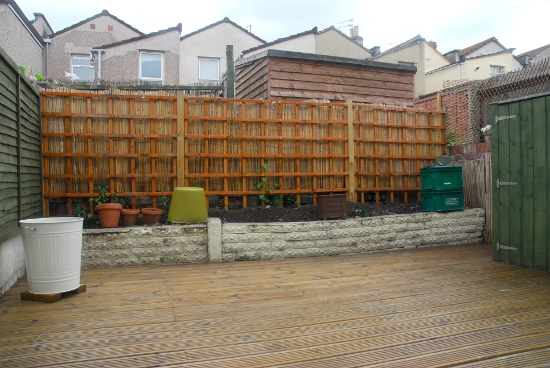
For the first 10 months after moving in, we did practically nothing to the garden, other than try to dig up the bindweed which quickly started poking itself up through the back bed. When spring came around, though, we decided it was time we started gardening. Time we started to make something of it.
Neither of us had ever designed a garden before, but we came up with a few basic principles.
- Our garden should be primarily an edible one; if we’re going to put all that work it, we wanted to get something to eat at the end of it.
- Above that, though, it should be organic and wildlife-friendly, up to the point that said wildlife start trying to eat the produce.
- “Wildlife” also does not extend to the cats from down the street who see the back bed and think “litter tray!”
- Pulling all that decking up would be far too much work. So our garden will be a container-based garden. Which does mean, for one thing, that if we decide we’ve planted things in the wrong places, we can move them all around later.
- We’d already discovered that the bed was full of bindweed rhizomes; digging those up, we discovered it was also full of broken glass and leylandii roots. So, for the first year, container gardening would be the thing, whilst we also dug up the bed completely, got rid of all the glass, bindweed, and lumps of coal, and put the soil back again.
That was back in April, nearly 5 months ago, and our embryo container garden has come a long way: potatoes, beans and various herbs all harvested, flowers bloomed and died, and our plans for next year’s season already starting to be formulated. I decided to start writing a blog about it for, well, several reasons. The main blog has been a bit moribund lately, and I thought having a well-defined topic might spur me into writing more. Moreover, I thought this blog could become something of a garden diary, helping us remember when we’d planted what, how long different plants had taken to develop, and compare things year-to-year. And, if nothing else, it can be a place for us to keep and discuss plans and ideas for future growth. It’s an extension of the original blog, and hopefully the name isn’t too confusing; our little patch of containers is very unlike a forest garden.
I’ll post again soon, with more introduction: a bit more about the situation and conditions we have to play with. For now, though, here’s a picture which, compared with the one above, shows how far we’ve managed to get in less than half a year.
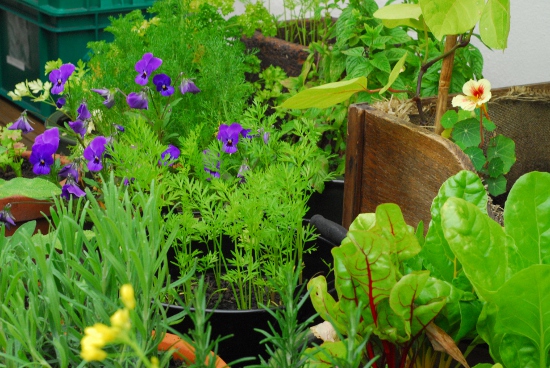
bindweed, blogging, introduction, overview



